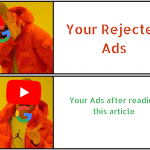 Membership TodaySign Up Now
Membership TodaySign Up NowVideo Transcription:
The Best Way to Reach your Audience when Advertising on YouTube
Hey, what’s up everybody, Justin Sardi from tubesift.com. And today we have an awesome video lined up for you. We’re going to be talking all about the best way to reach your target audience advertising on YouTube. And we’re going to be talking about my favorite targeting option and explaining exactly why it’s the best and how to get started.
Like I said, we’re going to be talking about the best way to reach your target audience advertising on YouTube today, and in my personal opinion, and also the opinion of the data that we’ve actually spent millions of dollars compiling, we found that placement targeting is one of the best ways to get a fast and high ROI on your YouTube ad campaigns. So when you’re targeting on Google ads and specifically targeting people on YouTube using YouTube videos, we actually have a whole blog post about all the different targeting options. And you can check that out by clicking the link either in the description of this video, or we’ll have a link in the blog below this as well.

We have all of those targeting options, but on there, we talk about one specific targeting option that seems to get people a fast ROI and a high ROI, and that is placement targeting. And as you can see on the screen, placement targeting essentially lets you target things like YouTube channels, YouTube videos, video lineups, which are new. I don’t personally use those. You can target websites and also apps, right?
You can basically target, like I said, YouTube videos, channels, websites on the Google Display Network, and apps on the Google Display Network. I personally don’t like using the Google Display Network for video ads, but I do like using YouTube, YouTube videos and YouTube channels. And we’re going to be talking all about that today.
What is a Placement on YouTube?
What exactly is a placement on YouTube? When you want to put your ad in front of your ideal customer, let’s say for instance, you have a beer brewing product, like you’d see here on the screen, right? Somebody on YouTube might be doing a search for something like how to brew beer. That person, at that exact moment in time, is looking for information on how to brew beer.
If we can put our ad in front of them at the exact moment that they are searching for what we have to offer, which in our case, if we’re using the beer example, maybe we have a beer brewing kit, right? We can throw an ad up in front of one of these videos that they’re going to be watching about how to brew beer and say, “Hey, in order to brew beer, you’re going to need this specific equipment. And we have a bundle kit that’s going to get you started right away. It’s got this, that, and the other. Click this video now to check it out.” Right?
You can see how ultra targeted that would be. And if we can put our video ad about brewing beer in front of somebody that is searching for information on how to brew beer, we have a very high chance of converting that viewer into a lead or a sale. And that’s why placement targeting is so powerful.
Placement Targeting with YouTube Ads
We’ve all seen YouTube ads, the in-stream ads. And we actually have a blog post all about in-stream ads and all the components, but as you can see right here on the screen, let’s say I go to watch one of those videos. I actually clicked on the first one in the search results about how to brew beer. This particular ad pops up. This ad is showing up on what’s called a monetized video and placements only work if the video has monetization enabled.
Essentially what that means is the YouTube creator, whoever is uploading the video to YouTube says, “Yes, I want to make a little bit of money or I want ads to be shown in front of my video so that I can make a little bit of money.” And essentially, what happens is they become part of the Partner Program on YouTube and YouTube then allows them to put ads in front of their videos or allows advertisers like us to place ads in front of their videos, and the creator that has the ad placed in front of the video gets a portion of that ad revenue.
It might not seem like a lot when you’re only paying a penny or so a view. However, some of these creators are getting millions of views per video, and they have lots and lots of videos that are getting millions of views, so those pennies really start to stack up. A million pennies, that’s great, right? As you can see over here, we have this in-stream ad that showed up over the beer brewing website, sorry, beer brewing video, and they are pushing a Kickstarter project. And we talk about all the components of a YouTube ad in the…
An in-stream ad, in one of our other blog posts. You can definitely check that out (click here). But basically, this video shows up and it is placed in front of a monetized video all about brewing beer. If this video were for some kind of product about brewing beer, you could see how hyper-relevant it would be, right?
Place your Ad in Front of your Ideal Audience at the Right Time
Finding the Right Audience for your Ad can be the Light Bulb moment that makes the difference in your ad campaigns.

Essentially, like I was saying, placements allow you to place your video ad in front of other hyper-relevant videos that your audience is watching. You’re basically putting your ad in front of your ideal audience at the exact moment they’re searching for what you have to offer, which then brings me to a couple of our best practices for placement targeting.
One thing really quick before we get into these best practices is you don’t actually have to have a video ad to use placement targeting. You can actually use what I like to call a video overlay ad. Technically, it’s a display ad placed on YouTube, but we have a whole blog post and a full training about setting those up, and you can check that out by finding the link in the description of this video or underneath this blog post as well. But that’s a whole other topic and we have a bunch of information covering how you can use placement targeting without having to have an ad or without having to have a video on YouTube.
Finding Targeted Video URLs
Obviously you’re going to need to find placements in order to target placements on YouTube, right? And the way those work is you’re going to need a list of video URLs that show up for a specific keyword. And you basically take those video URLs and you paste them into Google ads, and then anytime anybody watches one of those videos, your ad is shown in front of it or if you want to use the overlay ad, it’s shown over it.
What you’re going to need to do is either do this the manual way, where you go to YouTube, type in your keyword, click the first video, copy that video URL, paste it into a document, click back, go back to the second video, click that video, copy that video URL and go down the list.
That’s a very tedious process and that is actually why TubeSift was originally made because I was doing that process manually, and it did provide great results. However, it was taking me hours of time every single campaign, which is where TubeSift came from.
I was like, “Hey, we need something that can do this automatically.” TubeSift is going to find only the monetized videos, ensuring that you know these videos allow you to put an ad in front of them, and also helping you put your ad in front of hyper-relevant and hyper-targeted videos. The best way to find these placements is obviously to use TubeSift, but you can also do it the manual way if you have a few hours.
How to Find Highly Relevant Video Placements
Knowing how to find the best video placements can be tricky but there are some important tips to keep in mind.
Now let’s get into a couple of tips for the best way to find highly relevant video placements. I like to use an example, let’s say you are selling mortgages or maybe you’re trying to generate leads for a mortgage broker or something along those lines, right? So you can’t just go over to TubeSift or YouTube and type in “mortgage” because… Or maybe you could type in “best place to get a mortgage.” But for the most part, people are not searching YouTube for those kinds of things, right?
You have to really think like your audience. And this example is one that I really like to use because it just hits home and makes a lot of sense, right? If somebody’s searching for, let’s say somebody is shopping for a new home, right? You know that your audience is going to be doing a little bit of research. So when I first bought my first home, I was wondering things like tips for first time home buyers, types of home loans. And these are the things that people are actually searching for on YouTube.
Sometimes, if your main keyword doesn’t quite work for the search phrase or maybe there’s not a ton of traffic, you’re going to need to branch out a little bit and think a little bit more like your audience and target something like first time home, whatever, right?
I like to come over to YouTube and I just type in “first time home” and you could see all of these auto suggest keywords right here. TubeSift has an auto suggest keyword feature, but just high level stuff, I like to go over to YouTube and just type in “first time home” and you can see like buyer, buyer tips and advice, buyer programs, buyer loans, things like that. Those are the keywords that first time home buyers who are going to need a mortgage are going to be searching for. So if you could think like your audience and really zero in on the exact things they’re going to be searching for, you have a very high chance of finding amazing placements using TubeSift.
How to Use Keywords in Placements
When you’re searching for placements using TubeSift, you can find up to 300 videos per keyword, but I would not recommend doing that. And if you’re doing it the manual way, finding 300 videos is going to take you forever. So what I like to do is not go too deep on one keyword. And if you think about it, it makes a lot of sense to only find maybe the top 30, 50, or even 100 monetized video placements for each keyword.
And the reason it makes so much more sense to do that is because if you’ve ever done a search on YouTube or Google and you’ve gone 10, 20, 30 pages in, the search results start to get not quite as relevant, right? And nobody’s going to go 30 pages in to watch a video.
Let’s take roasting coffee at home for example. Let’s say you’re selling a coffee roaster or a coffee roasting online course, something along those lines. Somebody might go to YouTube and search for a video like, or search for a phrase like how to roast coffee at home. And you might want to find the top 30 videos for that. Then you need to think a little bit more outside the box. So what else might they be searching for that would yield similar results that also allows them to roast coffee at home? So I like to think a little bit, and maybe it might be DIY coffee roasting. It’s exactly the same thing. It’s a very closely knit keyword. However, it’s not exactly the same.
You’re going to find other videos, so you’re really going to broaden your search out and you’re going to reach a much broader audience, but they’re also going to be closely knit because DIY coffee roasting is literally roasting coffee at home, unless you’re roasting it in your office or whatever it might be.
Those two search terms are synonymous. If you could think of other synonyms for specific keywords, and they don’t even have to be actual synonyms. They can just be DIY and at home, right? They’re essentially the same thing because people are mostly doing DIY projects at home. So that’s how I like to find all of my placements and I go from there. So I’ll just think of a few different search terms. And we actually have a full worksheet and training on my process for going through and finding these and you can get that on our blog at blog.tubesift.com right below this video.
Use Different Angles
My next tip is to try different angles. Let’s take, for example, a YouTube advertiser. I have a course on running YouTube ads and I also have a software on running YouTube ads. So obviously, I want to reach people who are interested in running ads on YouTube. I always start by thinking about who exactly is interested. And in this case, it would be people who are wanting to run paid traffic. Pretty simple, high level targeting, people who want to run paid traffic. Just right off the top of my head, obviously, I would want to target people who are interested in running YouTube ads.
That is the lowest hanging fruit, but I don’t want to narrow myself down just to people who want to run YouTube ads because part of my job is to convince people who might be running let’s say Facebook ads that, “Hey, if you’re running Facebook ads, you might want to jump over to YouTube, not keep all your eggs in one basket, not mess around with all that crazy stuff going on with Facebook ads right now.”
You can see from this screen I’m sharing right now who’s interested, what people who want to run paid ads. Then there’s two categories, there’s YouTube ads and Facebook ads. Those are going to be two different angles that I’m going to take and I’m going to create two separate ad groups for those things.
I’m going to separate my placement lists by ad groups. And you can see right here on the screen, I actually did this. I was actually targeting people who wanted to run YouTube ads and also people who were currently running Facebook ads or who wanted to run Facebook ads. Both of those people are interested in running online advertisements, but it’s slightly different audiences.
I split those out into two different ad groups to test them and see which one was going to work best for my particular ad and for my particular campaign. And we actually found out that they both worked amazingly well, and so we continued running both of those and split those off into their own campaigns in the end.
Use TubeSift to Automate the Hard Work
Hopefully this short video helped you understand a little bit more about placement targeting and some of the best practices for targeting using placements on YouTube. As always, you can jump on over to tubesift.com and sign up for a TubeSift license. Automate 99% of the hard work, find hyper-relevant keywords, hyper-relevant placements, as well as create all of your graphic creatives that you’re going to need to run these types of ads at tubesift.com. If you liked this video, please subscribe to us on YouTube. Give us that thumbs up, leave us a comment. Let us know if there’s anything else you want to know about. And that is it for me on this one. Bye for now.
 Membership TodaySign Up Now
Membership TodaySign Up NowResources
- Targeting Options for YouTube Ads from the TubeSift Blog
- How to Use Video Overlay Ads (Display Ads) – Advertise on YouTube Without a Video from the TubeSift Blog
- About targeting for video campaigns: https://support.google.com/youtube/answer/2454017?hl=en



Comments are closed.